
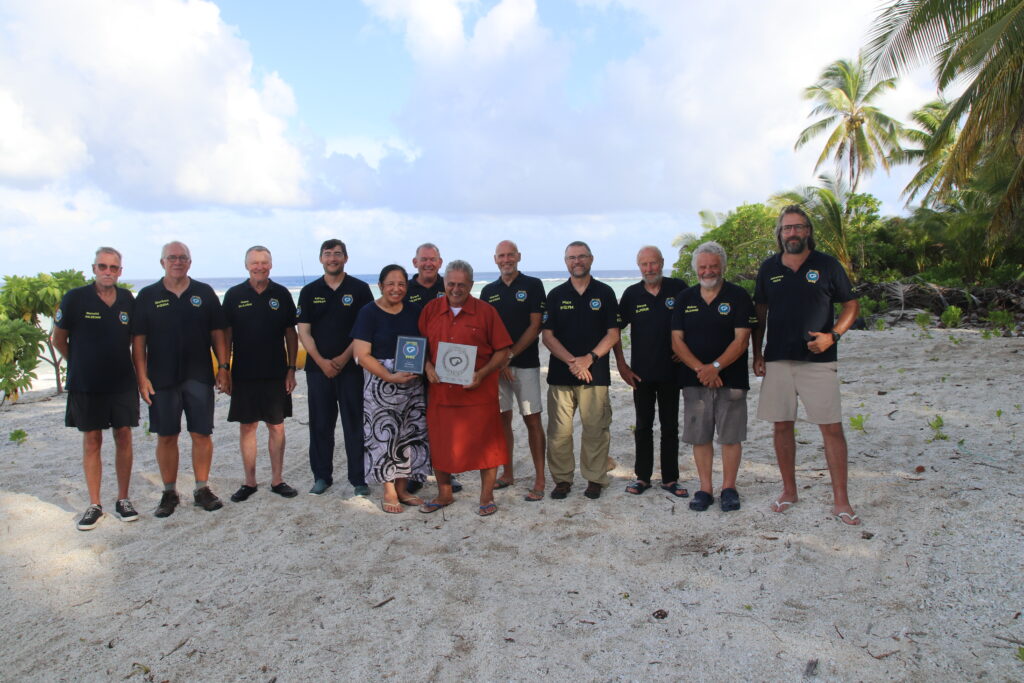
It was in 2016 when Hans, DL6JGN started his first e-mail exchange with Alexander E. Jennings regarding a possible DXpedition to Swains Island. Alexander (Alex) is the owner and representative of the island and therefore you need his permission to operate from Swains Island. Three years later the plan became firm, and a contract was signed for the transport ship and the support on the island. A team of ten operators was organized, including an operator/doctor. A few months later the call sign W8S was claimed, a web site was set up, en announcements made in the DX community and clubs and sponsors approached for their financial support.
The team started to plan and prepare all the equipment and materials and booked their flights. Early 2020 everything was ready to go but then problems started to pop up. First a measles breakout in American Samoa, a hurricane that damaged the ship and next, a global Covid outbreak. As a result, we had to decide to postpone the DXpedition, not knowing how long that could last.
It was until May 2023 that the situation was OK again and a new contract could be signed. Since four of the original operators could not join the DXpedition anymore, we had selected four new operators to complete the team of ten operators.
In addition, we also organized a team of pilots: Francisco HK3W – South America, John G4IRN – UK, Joe DL7JAN – Europe/Africa, Champ E21EIC – Asia, Lee VK3GK – Oceania, Steve N2AJ – US, and chief pilot and responsible for social media Alex PA1AW.
We started making plans and assigned tasks to each operator (antennas, equipment, IT, operations, camps, etc.). Every two weeks we had a Zoom meeting to discuss progress, issues, problems, etc. At the same time, I had every other week a Zoom call with Alex and his team. Once the antennas and equipment were defined, we started to collect all the materials that could be shipped in advance. Coax cables were cut to the specific length for each antenna. All coax and data cable between the laptops, radios and amplifiers were made and labeled, so nothing could go wrong in setting up the stations.
We choose to use only Elecraft K3 (modified) and K3S radios and SPE Expert 1.3K amplifiers. With several spare radios and amplifiers, we could easily and quickly replace a defective radio or amplifier. An overview of the equipment can be seen here.
All radios and amplifiers would be transported as personal luggage. Masts, coax, antennas, tools, etc. were packed in wooden boxes and shipped in advance to American Samoa.
We planned for two camps (Red and Blue) that would be 400 meters away from each other. With that, and in addition the high power BPFs, we would be able to operate CW and SSB on the same band.
On September 27, the operators started their journey from the Netherlands, Germany and US and would gather at Hawaii from where we flew to American Samoa. From September 29 – October 2nd the team was staying in Pago Pago (the capital of American Samoa) to do some shopping for last preparations (wood, steel pipes for masts, mosquito repellent, guy stakes, wood, etc.). Since we found the six wooden boxes damaged, we decided to buy plastic boxes to repack all the materials, except for two wooden boxes that were reinforced to carry the fiber masts.
To our surprise we were informed that the schedule of the ship was delayed by 2 days. This was a big disappointment. We went to the port authorities and had a meeting to discuss the situation and what we could do to avoid further delays. We got a commitment from the port authorities that we would leave Pago Pago on October 5th. However, the voyage was not directly to Swains. We had to visit Manu’a and Ofu islands first after which we went to Swains Island. As a result, the voyage would take 30 hours instead of 22 hours.
October 4
We went to the port in the afternoon but had to wait until 10 PM before we could board the Manu’atele. On board we had good chairs for the long voyage to Swains, but some of us were seriously struggling with seasickness. They really had a hard time all the way. The whole voyage took about 30 hours to arrive at Swains Island.
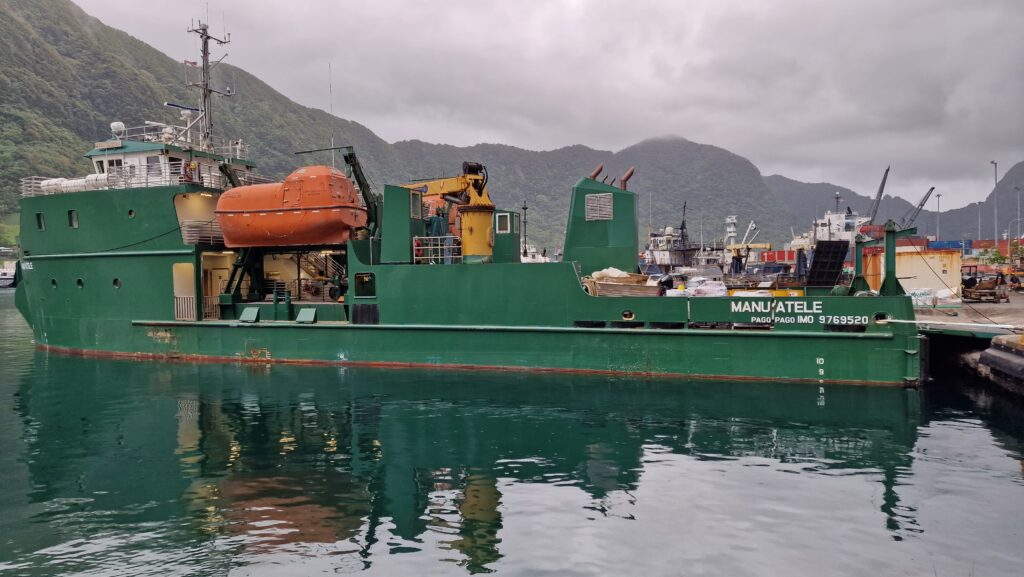
Our ship Manu’atele for our transport to Swains Island.
October 6
We arrived at the island around 04 AM but had to wait until 07 AM, some hours before high tide (09 AM), to offload all the materials and get the people on the beach. A flat bottom landing vessel was used to bring people and materials from the Manu’atele to the beach. This took about 4 hours after which the Manu’atele left for Pago Pago.
Martin and I immediately started to walk along the beach to identify the location for the Red and Blue Camp. After this was done, the support team transported all our boxes and suitcases to the respective camps locations. Since all boxes were marked red or blue, it was easy to get the right materials at the right camp. After the materials were at the camp locations, four operators per camp started to build the antennas. At the same time the support team built the tents and installed the tables and chairs for the operations.
October 7
The first day we erected about half of the antennas and built the radio stations. It was extremely hot, and we also had some heavy showers. We were all exhausted. As soon as we had some radio stations and antennas ready, we started our initial operation. That was on October 7 at 08:31 UTC (07:31 PM local time). The next day we continued with the antenna building and started our full operation. We had a shift plan scheduling two operators per camp and ensuring 24 hrs. a day operation.
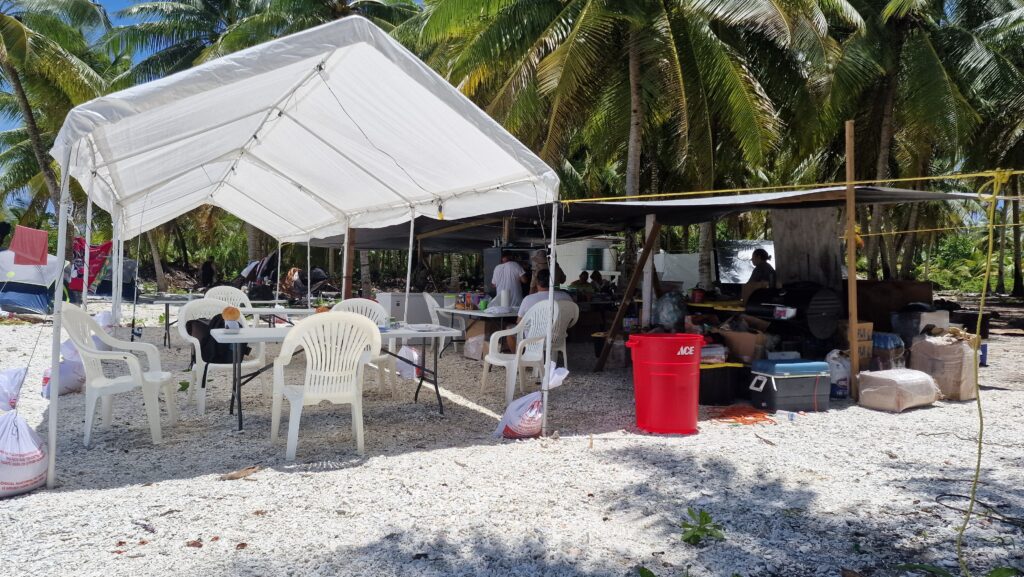
Dining and relaxation area with kitchen.
Alex his support team in the meantime built the Base Camp that consisted of the kitchen area with storage for food, water and drinks, two sleeping areas for the operators, a shower area and two toilet buildings. The four ladies that were running the kitchen did an outstanding job. When arriving at the Base Camp after we had done our shift, we were asked what to drink and/or what to eat. We often got cold coconut drinks, soda, fruit drinks, etc. In the morning around 07 AM we had breakfast and around 6 PM we had dinner. Every day we had different food, ranging from fish, lobster, crab, chicken, beef, turkey and always with a nice desert. It was like a great restaurant. This made the tough living on the island certainly more enjoyable.
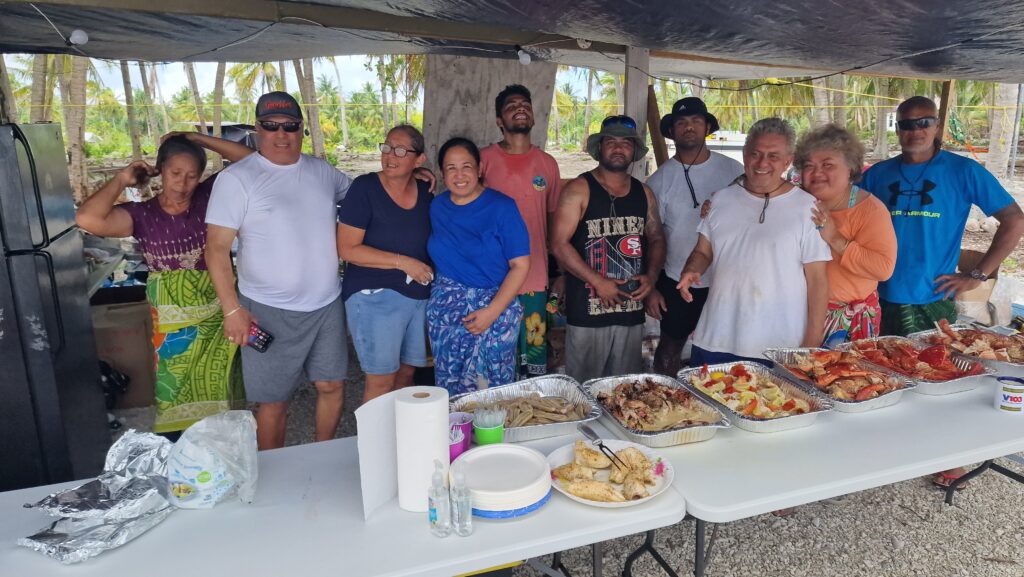
Every day we had fantastic meals.
For sleeping of the operators, two tents were set up in which each tent could accommodate 5 sleeping beds. Each operator had his own mosquito tent with mattress. The support team also provided a shower area where they supplied two barrels with water (from the lagoon) every day. We used it for showering and doing our laundry.
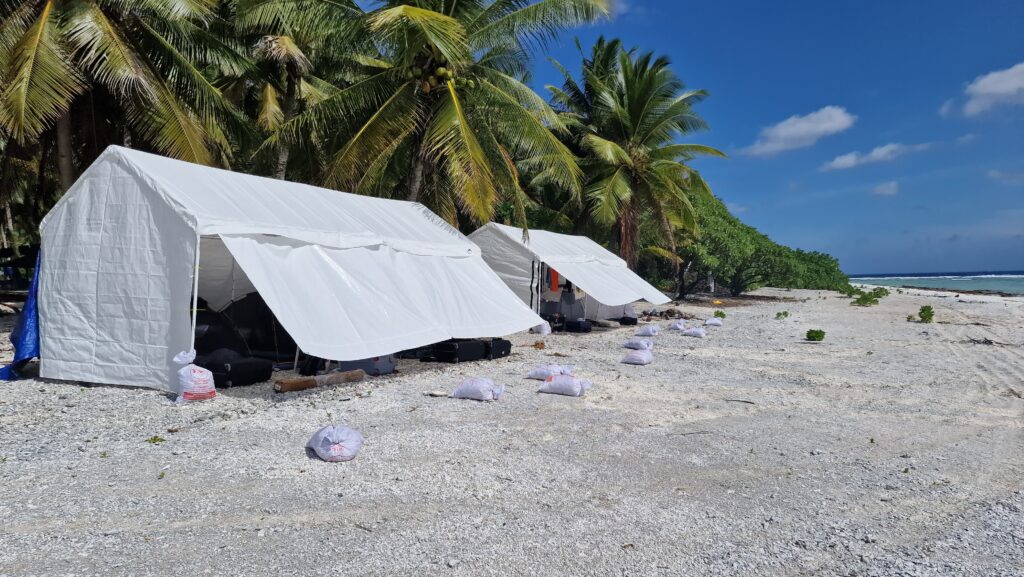
The two sleeping tents for the 10 operators.
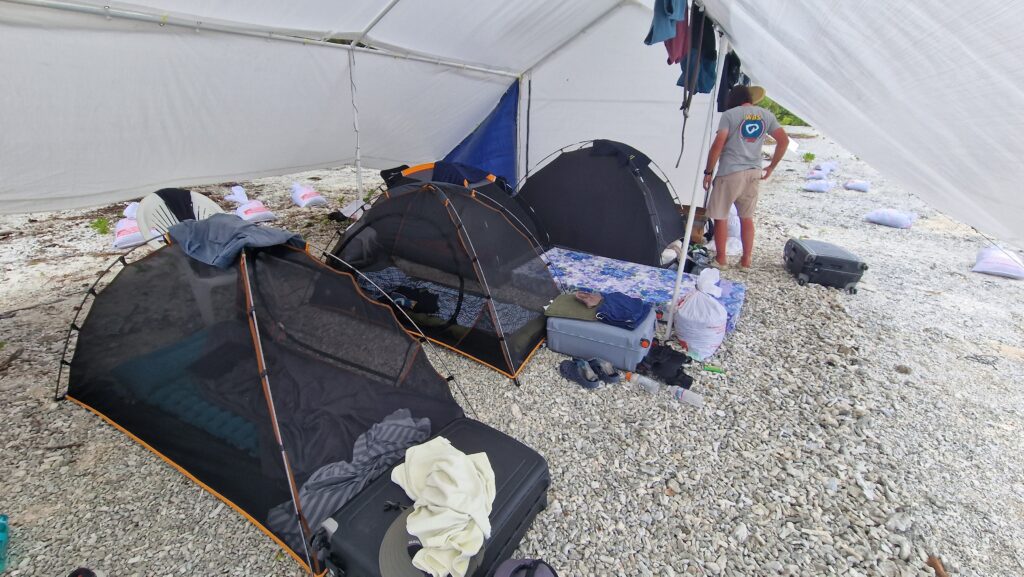
Sleeping tent with individual mosquito tents.
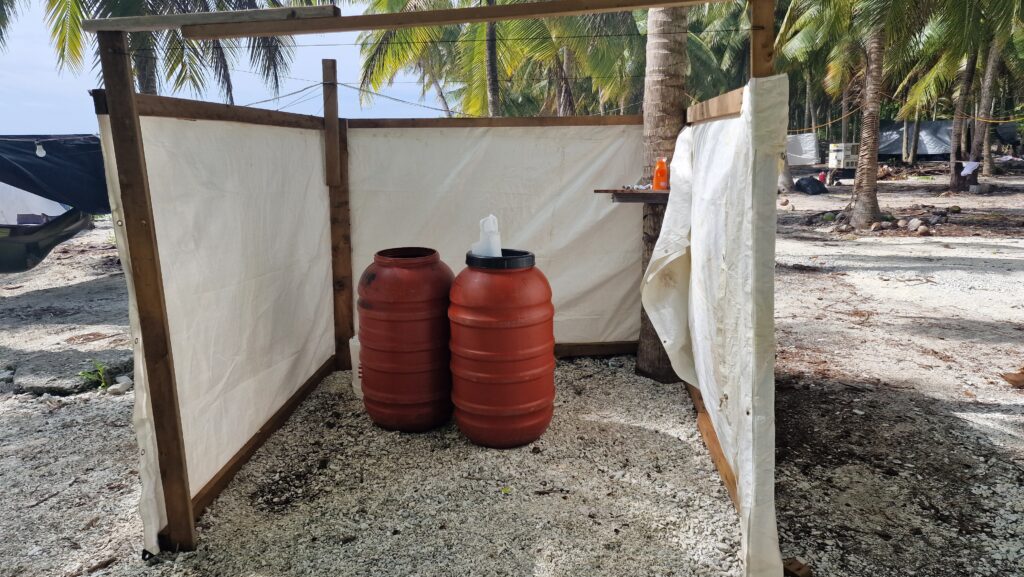
Shower and laundry area.
The small toilet building had two toilets which could be flushed with water coming from two big drums.
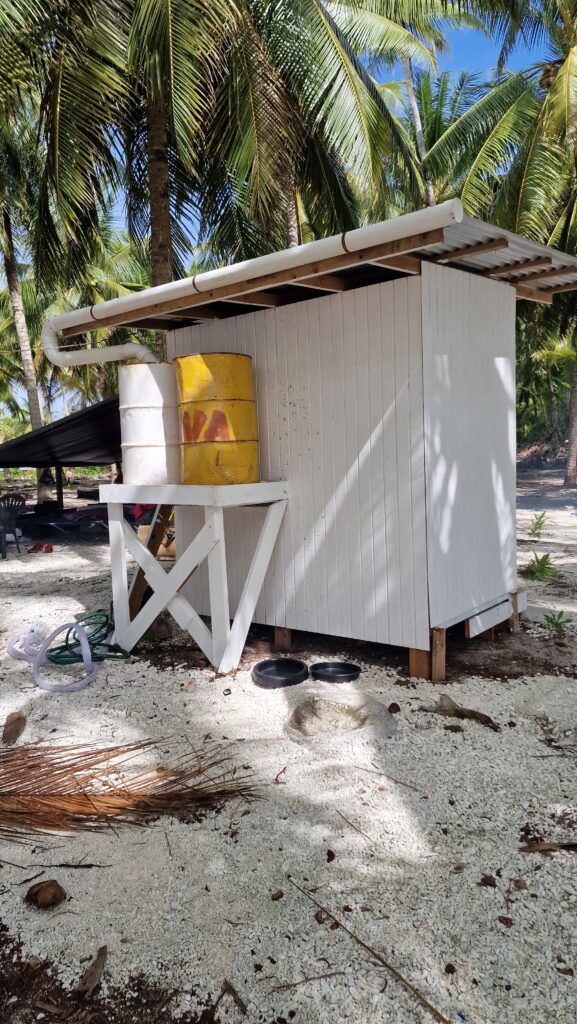
Toilet building.
October 8-16
With two operators per camp, soon it was already common practice for operators to operate CW or SSB and FT8 on the 3rd station at the same time. This meant that we could operate very efficiently.
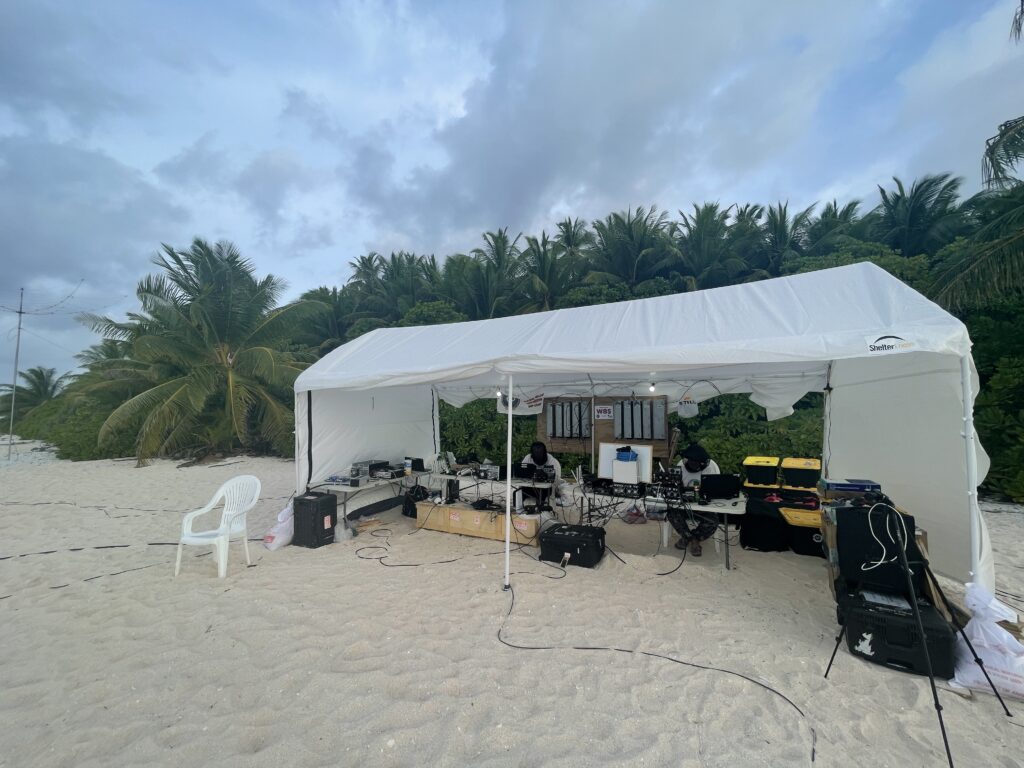
Red Camp operating site.
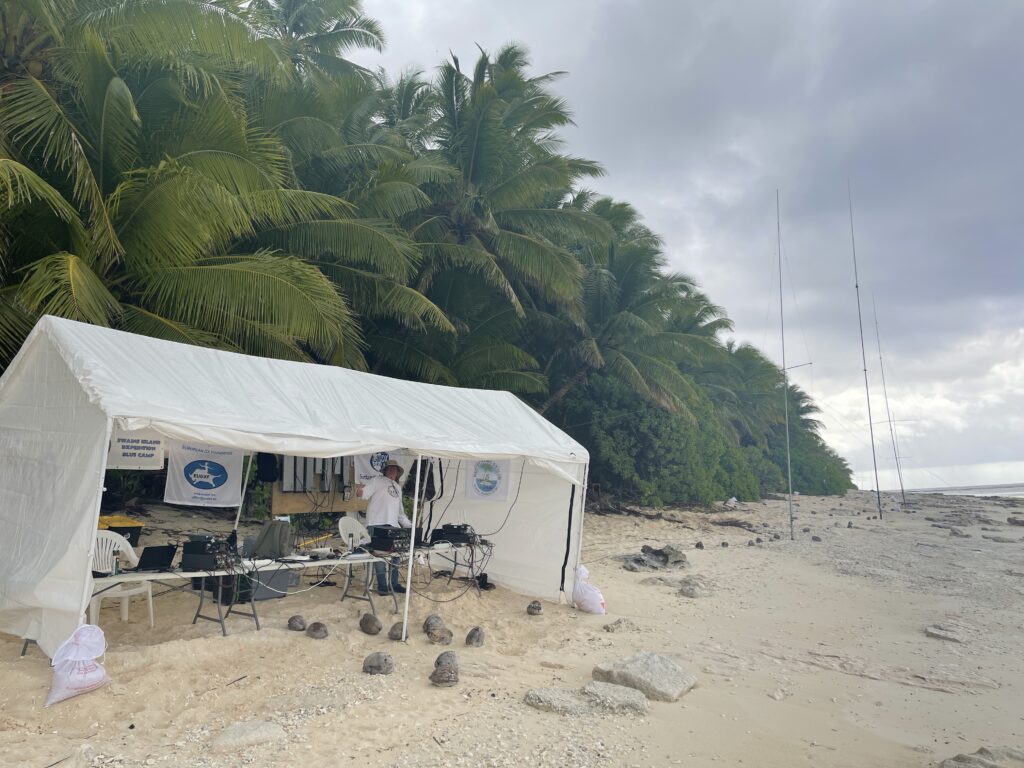
Blue Camp operating site.
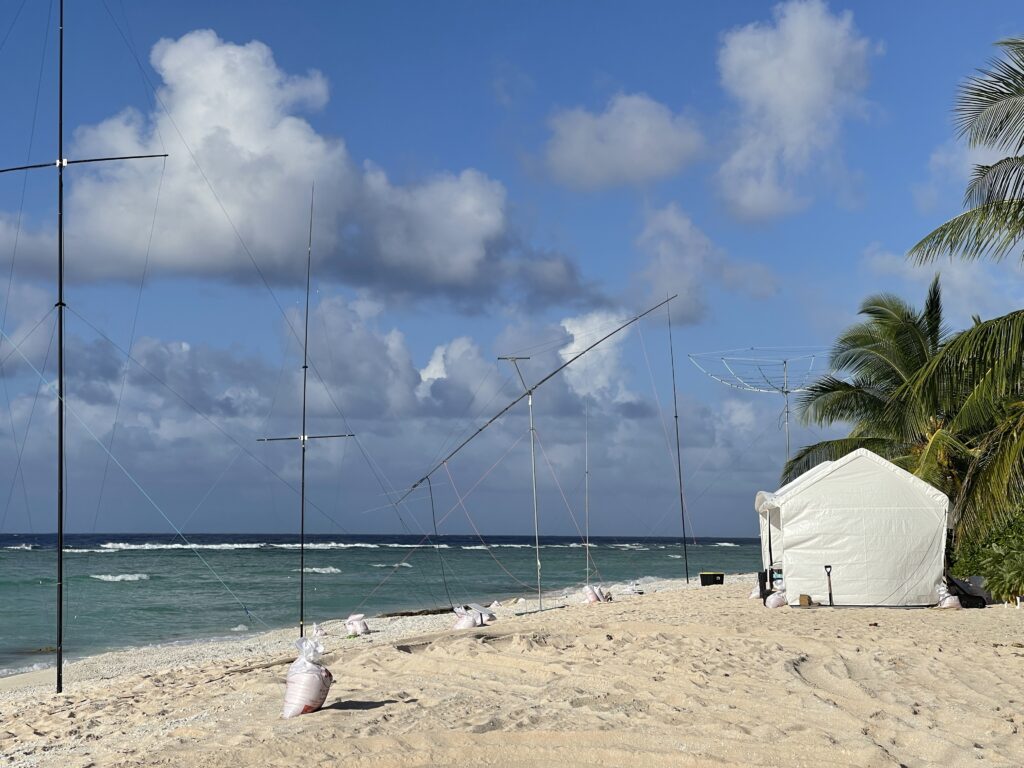
VDA’s, Hexbeam, 6m yagi and phased vertical.
We heard from many people, especially from Japan, that they were extremely interested in a 6m contact. For that reason, we had decided to build an additional station specifically for 6m. That would also include EME activity, which would be the first ever activation from Swains. However, the erection of an 8 element 6m yagi on a 6-meter-tall pipe was not an easy task. With the help of most of the operators and some of the support team, we managed to get the yagi up. By means of ropes the antenna could be rotated and elevated. With the 6m station ready, operation could start and many 6m contacts were made. Quite some effort was put into trying to make EME contacts. First, we learned that some stations were able to hear us, but we could not hear them. But we continued to make new attempts and finally we got 3 EME contacts in the log.
Our daily activities were based on a shift plan for the entire team. The 10 operators were divided into 5 teams of 2 people and running shifts of 3, 4 and 5 hours per camp. With the shift plan, each operator would operate on different times of the day, work alternating from Camp Red or Camp Blue and had various rest periods for sleeping and activities of their choice.
Especially in the first days, the rest periods were also used to set up more antennas and organize the operating positions.
However, the walk from the Base Camp to the Red or Blue Camp was quite an exercise and when arriving at the camp you would need to cool down a bit (especially during the day) and relax a bit. Soon we suggested to the support team if they could use their ATV and transport the operator to and from the camps. They agreed to do so, and we provided them with a shuttle schedule. From that moment we go by transport to the camps, even at night and 03 AM. This was a big relief to the team.
A unique element of the DXpedition was having very good internet access. This was provided by a Starlink terminal with unlimited internet access 24 hrs. a day en going to 160 Mbps. This allowed us to upload our logs (primary purpose of the internet link) daily to the QSL manager Charles M0OXO. But further it allowed us to have online interviews with clubs or organizations, talk to our chief pilot, have contact with our family and friends and provide for the first-time internet access to the support team.
During all days on the island, we were focused on making as many QSO’s as possible, dividing operations over the different modes and paying attention to all regions of the world. Obviously, it is easy to work Japan and to a lesser extend the US. Europe was more challenging, especially norther Europe where we had to cross the north pole which caused disturbance of the signals. Finally, we were happy that the number of QSO’s was equally divided over the US, Europe and Asia.
As soon as we had our first operations on 160 and 80m we experienced that we did not really need the K9AY receiving antennas and therefore decided not to install them.
Each camp consisted of 3 radio stations, comprising of a Elecraft K3 and an SPE 1.3K amplifier. Besides the low power BPF between the radio and amplifier, we also had high power BPF’s after the amplifiers. They were mounted on a wooden pannel that was situated behind the operators. The antennas were directly connected to the BPF’s and the operator could choose the band for the operation by connecting the cable from the amplifier to the respective BPF. With this method, you avoid operators accidentally start operating on the same band.
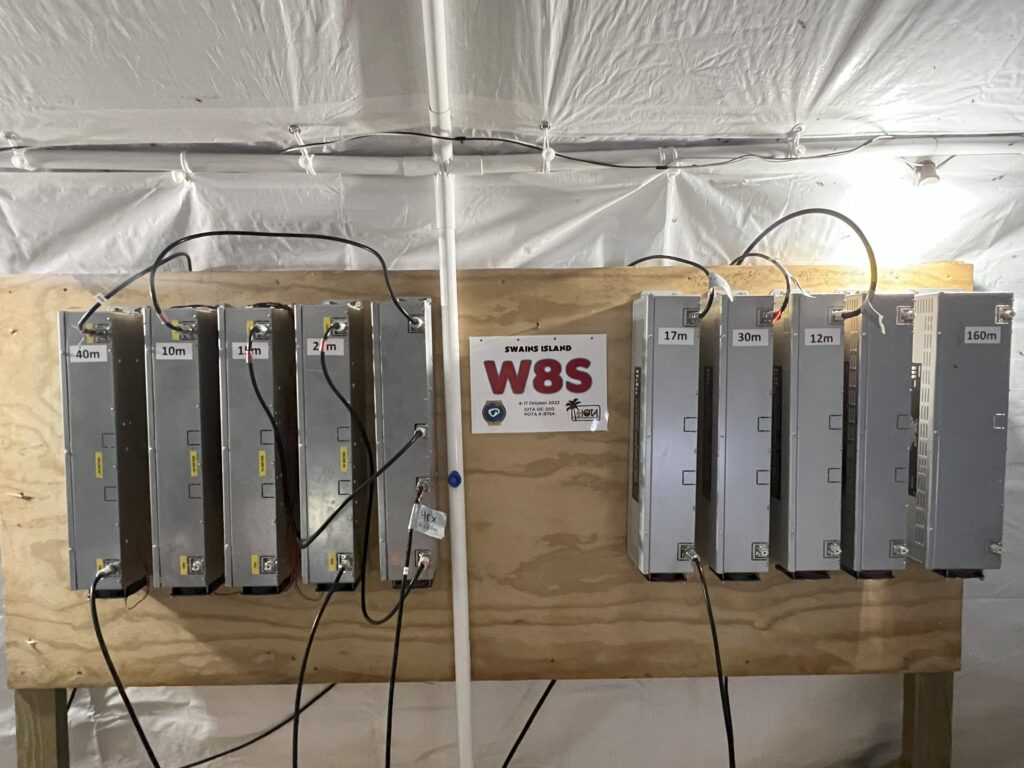
High power BPF’s and combiner (4O3A).
For 6m operation we had an additional station with a FlexRadio and RF-kit 2KW amplifier.
Over the whole operation we had one K3 and one SPE becoming faulty but for the rest, all equipment and generators worked flawlessly.
As we know from the previous DXpeditions to Swains, the heat and mosquitoes would be our biggest enemies. For some of us that was right to the extreme. Although we brought enough insect repellent, it was not always sufficient.
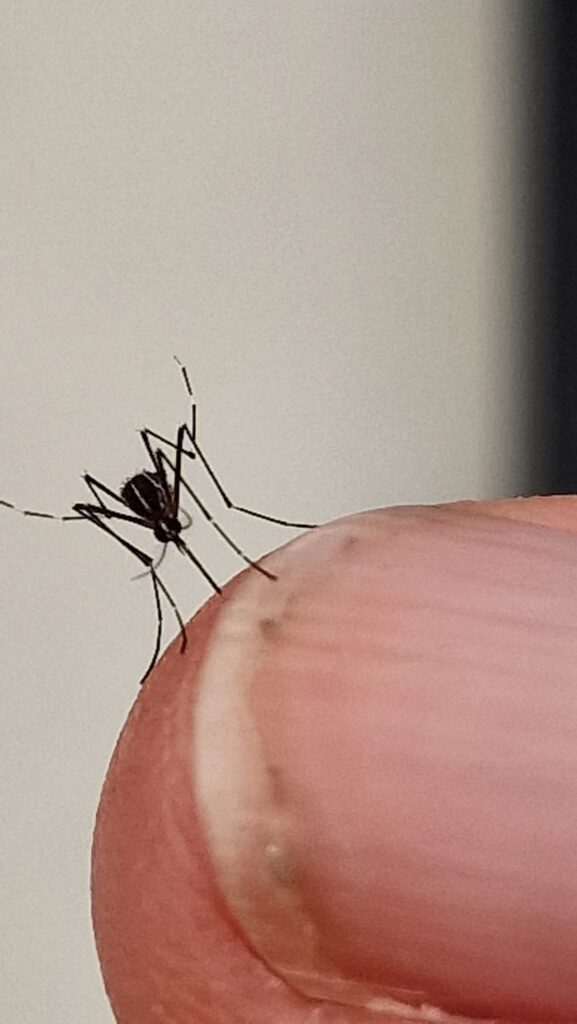
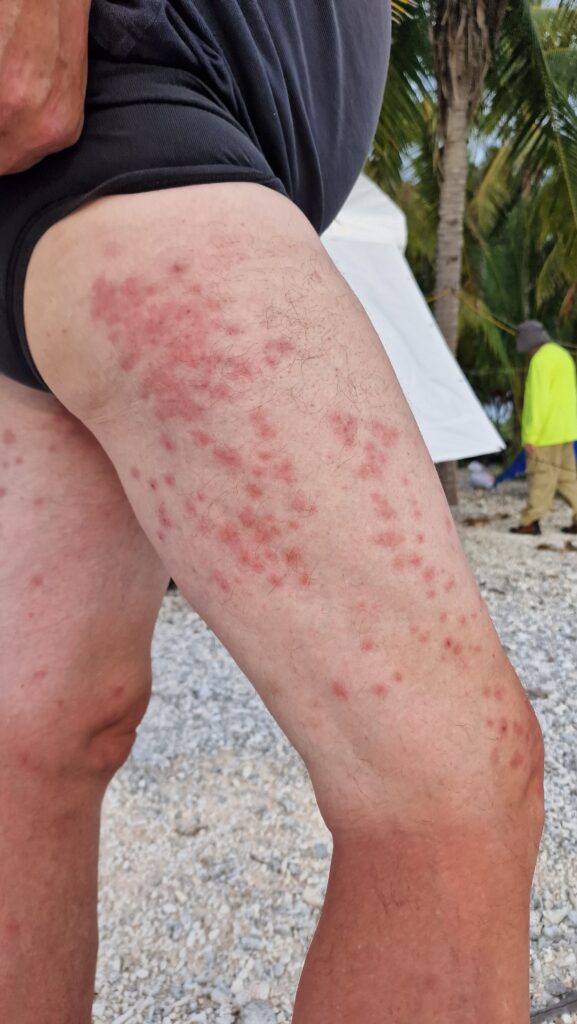
Mosquitoes, our biggest enemy.
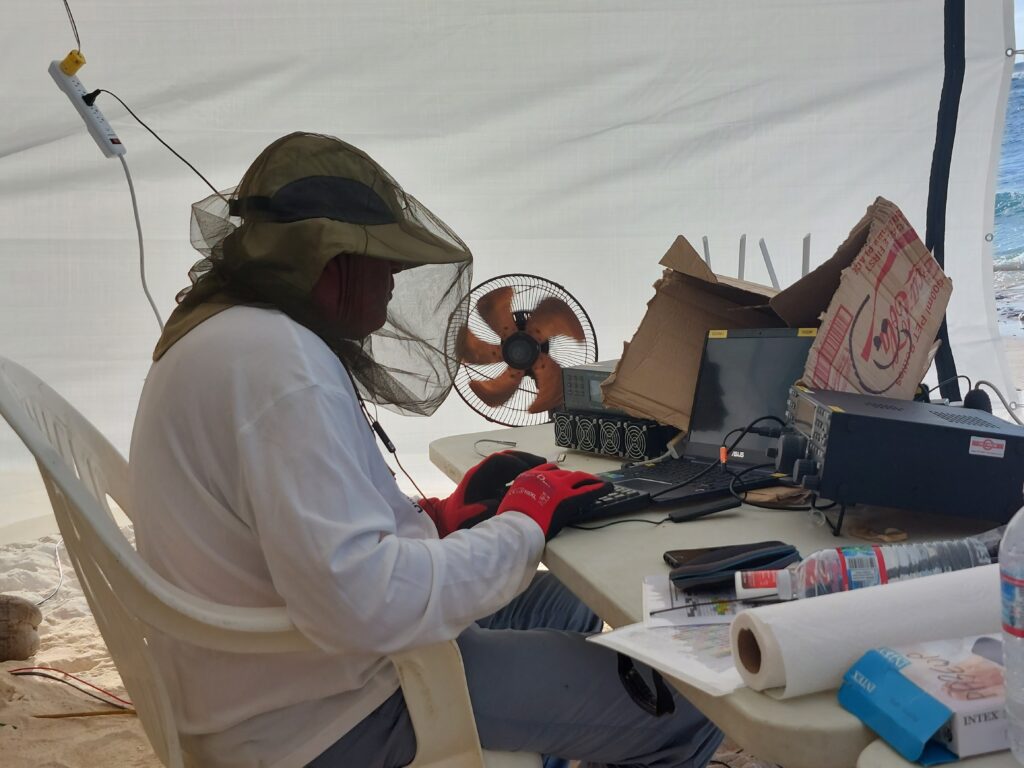
Evert PA2KW trying to protect himself.
When we were nearing the end of our stay on Swains Island, we started to discuss in the team how and when we should dismantle our camps. The schedule was that we would return to Pago Pago on October 17. Since the time to load all equipment and materials on the Manu’atele should happen in a short period of time, it should be planned well. We learned that the Manu’atele would already arrive at Swains Island in the afternoon of October 16. This allowed the support team to transport some materials from the main camp in the afternoon.
We got instructions to be ready for departure at 03 AM local time on October 17. With that we could estimate when we had dismantled our camps, and everything packed and transported to the beach. We first started to dismantle the Blue Camp which was farther away from the Base Camp.
We decided to dismantle the camp in the evening/night as it would be less hot. We started on October 15 at 07:30 PM and finished at 11:30 PM. This was an indication for the Red Camp how long they would need to have their camp dismantled and packed. In the afternoon of October 16, the Red Camp was also packed and transported to the beach. We gathered at the Base Camp discussing the DXpedition and how it went and enjoyed some last food and drinks before taking a short nap.
October 17
Around 03 AM we were all up and had packed all our personal things and were gathering again at the kitchen area, which was already in the process of being dismantled and packed by the support team. We were watching how all the tents were taken down and fortunately there was no rain.
As soon as the tide was right, the landing vessel arrived, and the first load of the day was transported to the Manu’atele. In the following rides, passengers and cargo were transported and we finally departed for Pago Pago around 7 AM.
Some of us went to sleep and others gathered on deck. The captain told us that the sea was quiet but soon we experienced big waves bumping onto the ship. At one time, part of a wave went over the upper deck and some passengers got completely wet.
October 18
Around 06 AM we arrived in Pago Pago and the ship was quickly unloaded. We gathered all our suitcases and grouped together for transport to the hotel. Alex Jenning and his team took care of all our boxes and transported them to the home of Alex.
A public bus was arranged to take us to the hotel and when the bus started moving, the driver switched on his audio system with very load reggae style music. Everyone on the bus was singing and smiling.
In the hotel we could after a long time take a decent shower. During the day we were relaxing, discussing the fantastic DXpedition we experienced. That day we also went to Alex his home to add some materials to the boxes and secured them for the transport back to the Netherlands.
October 19
We were to visit two transport companies to discuss the transport of our boxes and asked for a quotation. We were invited by Alex to have dinner in the evening after which we would go to the airport to catch our flight to Hawaii.
In the evening we had a very nice dinner together with Alex and his wife, some people from the support team and the children and grandchildren of the Jennings family. All W8S team members received a traditional lavalava (a wrap-around skirt) and “Swains” T-shirt and two signed books about Swains Island. This was obviously highly appreciated by the team.
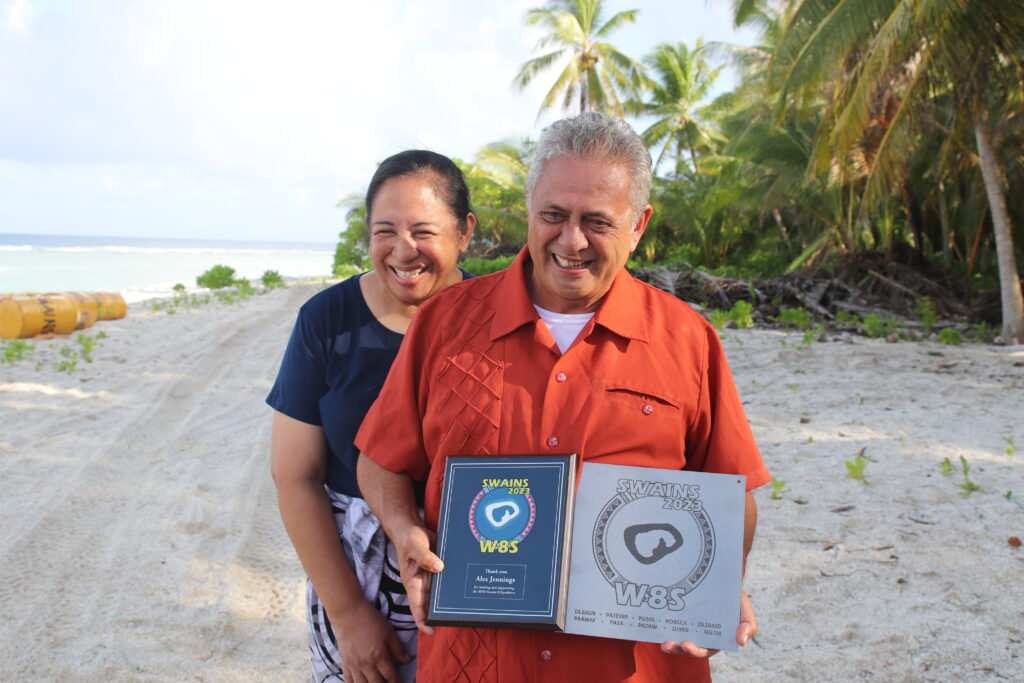
Alex Jennings and his wife receiving a plaque of appreciation.
Recap
Unfortunately, our stay on Swains Island was cut short by two days due to the ship schedule. This had an impact on our goal of 100,000+ QSO’s. Finally, we ended up with 91,847 QSO’s. All operators were very positive about how we operated as a team and how we were interacting with the support team. It was a great experience that we will long remember.
This DXpedition was only possible with the great help and support of Alex Jennings and his team. They have done a great job to make the DXpedition a success. Because Alex wants to further develop activities on the island, communications are vital, and it was the first time he and his team could experience unlimited internet access due to our satellite connection. To support Alex in his plans, we decided to donate the Starlink terminal to Alex.
We would also like to thank clubs, companies and hundreds of individuals for the generous support we received, which is essential to make a DXpeditions like this possible. We would also like to thank our QSL manager Charles M0OXO who has now the task of answering the many requests for a QSL card or LoTW confirmation.
